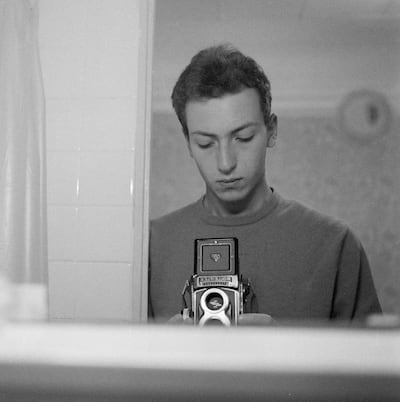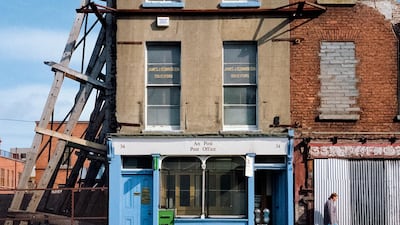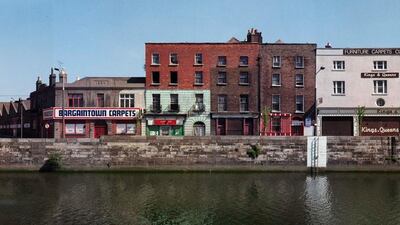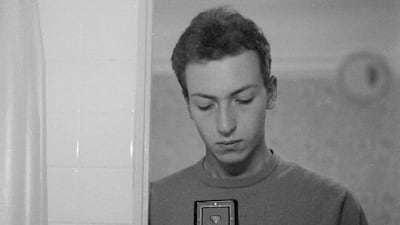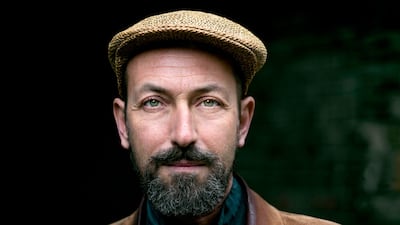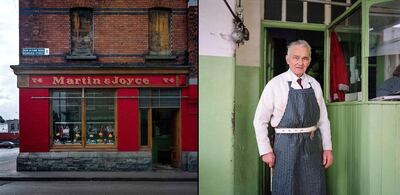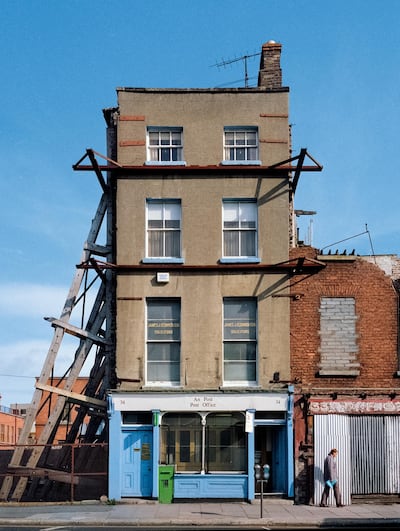Ireland in the 1980s was a place many people wanted to escape. The country was one of the poorest in Europe and huge numbers were emigrating every year. But for David Jazay, it was the other way around. The German photographer arrived in the Irish capital on a Sunday in 1982, as a teenage exchange student.
The inner city of Dublin at this time was home to the faded grandeur of British-era Georgian buildings that were under immediate threat of demolition. The area – where working-class communities had toiled for generations – was about to change for ever.
Few could anticipate Ireland’s boom years ahead – where the dizzying growth mirrored the UAE’s, with cranes filling Dublin’s skies – but Jazay grasped instinctively that this chapter in Dublin’s history needed to be documented before it was erased.
I was fascinated not so much by the dereliction but by the working-class culture and the small shop owners
"I was fascinated not so much by the dereliction, but by the working-class culture and the small shopowners," says Jazay, 54, who is from Munster. "People would chat to you, people had time, and there were children playing in the streets. It was all very different from the Germany I grew up in. I thought it was very beautiful."
The photographs he took show the last of the old antique houses, furniture sellers and corner shops that dotted the quays alongside the beautiful yet dilapidated "Georgian architectural ensembles", as Jazay calls them. The faces of shopowners, children and salesmen stare out from a departed era. And forget grey monochrome shots of poverty and decay: many of the images are immediate and colourful. It is clear Jazay was no misery tourist, but someone genuinely interested in what was happening.
“It boggles my mind that people see bleakness because what I saw was working-class people being able to make a living in the city,” he says. “It was my intention to photograph it in good light because I didn’t want to fall into that narrative of the bleak, depressing post-war thing.”
Jazay used a 1950s-era Rolleiflex T camera to document the era's twilight. It was a twin lens, analogue camera that he found relaxed people when he shot their portraits. "Because you look down and talk to them and make eye contact while you take photos, so it is a very good street camera."
One striking images is of a Sikh trader at an inner city bazaar. "I didn't consider it unusual to see signs of an Asian community, even if Ireland was quite mono-ethnic in those years."
Jazay returned to Ireland every two years, and in 1985 shot a continuous panorama of Dublin’s north quays that line the River Liffey. He would walk 20 metres, take a shot and then do it again. The beauty of the architecture remained despite the poor condition of the buildings and “ghost signs” – previous shop names – were still visible. “It was like a layer cake of history,” he says. “You could actually see the different uses people had put these buildings through in the course of time. All that is gone now, and doesn’t seem to be missed much. But I saw the life in it.”
Jazay snapped about 4,000 images in total and, a few years ago, he scanned some and put them together in digital panoramas. The result is a striking record of Dublin in the latter half of the 1980s. In 1988, Jazay also completed a documentary with Judith Klinger, called Bargaintown, which chronicles some the people he met.
By 1992, the work had finished and Dublin had moved on. Ireland was about to experience a huge economic boom called the Celtic Tiger. The years from 1995 to 2007 were an unprecedented time in Ireland's history, when the country went from being one of the poorest to one of Europe's wealthiest.
Jazay did not visit between 1996 and 2013 as new construction and infrastructure projects transformed the city he chronicled – many buildings were demolished or rebuilt with mock facades – and the places Jazay photographed are now largely redeveloped. The boom was followed in 2008 by one of the sharpest downturns in history.
Jazay named his collection "Dublin Before the Tiger" and it represents a warm and intriguing snapshot of a time and place in the capital's history that has been lost for ever. Jazay is now hoping to stage an exhibition of the photographs in Ireland.
"I've been going back for the past 10 years, and what really shocks me now is the empty brownfield sites. They should have done projects for the community such as rehearsal spaces, parks, sports grounds and things like that," he says.
"I have no wish to judge or indict, but would hope that people saw not just the poverty and dereliction of Dublin before the Tiger, but also the dignity of its people in the face of adversity, their crafts and traditions, and their sense of community."
More information about Dublin Before the Tiger is available at www.davidjazay.com
Cricket World Cup League 2
UAE squad
Rahul Chopra (captain), Aayan Afzal Khan, Ali Naseer, Aryansh Sharma, Basil Hameed, Dhruv Parashar, Junaid Siddique, Muhammad Farooq, Muhammad Jawadullah, Muhammad Waseem, Omid Rahman, Rahul Bhatia, Tanish Suri, Vishnu Sukumaran, Vriitya Aravind
Fixtures
Friday, November 1 – Oman v UAE
Sunday, November 3 – UAE v Netherlands
Thursday, November 7 – UAE v Oman
Saturday, November 9 – Netherlands v UAE
F1 The Movie
Starring: Brad Pitt, Damson Idris, Kerry Condon, Javier Bardem
Director: Joseph Kosinski
Rating: 4/5
UAE currency: the story behind the money in your pockets
COMPANY PROFILE
Name: Kumulus Water
Started: 2021
Founders: Iheb Triki and Mohamed Ali Abid
Based: Tunisia
Sector: Water technology
Number of staff: 22
Investment raised: $4 million
The burning issue
The internal combustion engine is facing a watershed moment – major manufacturer Volvo is to stop producing petroleum-powered vehicles by 2021 and countries in Europe, including the UK, have vowed to ban their sale before 2040. The National takes a look at the story of one of the most successful technologies of the last 100 years and how it has impacted life in the UAE.
Read part four: an affection for classic cars lives on
Read part three: the age of the electric vehicle begins
Read part one: how cars came to the UAE
From Zero
Artist: Linkin Park
Label: Warner Records
Number of tracks: 11
Rating: 4/5
Conflict, drought, famine
Estimates of the number of deaths caused by the famine range from 400,000 to 1 million, according to a document prepared for the UK House of Lords in 2024.
It has been claimed that the policies of the Ethiopian government, which took control after deposing Emperor Haile Selassie in a military-led revolution in 1974, contributed to the scale of the famine.
Dr Miriam Bradley, senior lecturer in humanitarian studies at the University of Manchester, has argued that, by the early 1980s, “several government policies combined to cause, rather than prevent, a famine which lasted from 1983 to 1985. Mengistu’s government imposed Stalinist-model agricultural policies involving forced collectivisation and villagisation [relocation of communities into planned villages].
The West became aware of the catastrophe through a series of BBC News reports by journalist Michael Buerk in October 1984 describing a “biblical famine” and containing graphic images of thousands of people, including children, facing starvation.
Band Aid
Bob Geldof, singer with the Irish rock group The Boomtown Rats, formed Band Aid in response to the horrific images shown in the news broadcasts.
With Midge Ure of the band Ultravox, he wrote the hit charity single Do They Know it’s Christmas in December 1984, featuring a string of high-profile musicians.
Following the single’s success, the idea to stage a rock concert evolved.
Live Aid was a series of simultaneous concerts that took place at Wembley Stadium in London, John F Kennedy Stadium in Philadelphia, the US, and at various other venues across the world.
The combined event was broadcast to an estimated worldwide audience of 1.5 billion.
War 2
Director: Ayan Mukerji
Stars: Hrithik Roshan, NTR, Kiara Advani, Ashutosh Rana
Rating: 2/5
Killing of Qassem Suleimani
What sanctions would be reimposed?
Under ‘snapback’, measures imposed on Iran by the UN Security Council in six resolutions would be restored, including:
- An arms embargo
- A ban on uranium enrichment and reprocessing
- A ban on launches and other activities with ballistic missiles capable of delivering nuclear weapons, as well as ballistic missile technology transfer and technical assistance
- A targeted global asset freeze and travel ban on Iranian individuals and entities
- Authorisation for countries to inspect Iran Air Cargo and Islamic Republic of Iran Shipping Lines cargoes for banned goods
Specs%3A%202024%20McLaren%20Artura%20Spider
%3Cp%3E%3Cstrong%3EEngine%3A%3C%2Fstrong%3E%203.0-litre%20twin-turbo%20V6%20and%20electric%20motor%3Cbr%3E%3Cstrong%3EMax%20power%3A%3C%2Fstrong%3E%20700hp%20at%207%2C500rpm%3Cbr%3E%3Cstrong%3EMax%20torque%3A%3C%2Fstrong%3E%20720Nm%20at%202%2C250rpm%3Cbr%3E%3Cstrong%3ETransmission%3A%3C%2Fstrong%3E%20Eight-speed%20dual-clutch%20auto%3Cbr%3E%3Cstrong%3E0-100km%2Fh%3A%3C%2Fstrong%3E%203.0sec%3Cbr%3E%3Cstrong%3ETop%20speed%3A%20%3C%2Fstrong%3E330kph%3Cbr%3E%3Cstrong%3EPrice%3A%3C%2Fstrong%3E%20From%20Dh1.14%20million%20(%24311%2C000)%3Cbr%3E%3Cstrong%3EOn%20sale%3A%3C%2Fstrong%3E%20Now%3C%2Fp%3E%0A
Our Time Has Come
Alyssa Ayres, Oxford University Press
NO OTHER LAND
Director: Basel Adra, Yuval Abraham, Rachel Szor, Hamdan Ballal
Stars: Basel Adra, Yuval Abraham
Rating: 3.5/5
Profile of Whizkey
Date founded: 04 November 2017
Founders: Abdulaziz AlBlooshi and Harsh Hirani
Based: Dubai, UAE
Number of employees: 10
Sector: AI, software
Cashflow: Dh2.5 Million
Funding stage: Series A
Lexus LX700h specs
Engine: 3.4-litre twin-turbo V6 plus supplementary electric motor
Power: 464hp at 5,200rpm
Torque: 790Nm from 2,000-3,600rpm
Transmission: 10-speed auto
Fuel consumption: 11.7L/100km
On sale: Now
Price: From Dh590,000
Specs
Engine: Electric motor generating 54.2kWh (Cooper SE and Aceman SE), 64.6kW (Countryman All4 SE)
Power: 218hp (Cooper and Aceman), 313hp (Countryman)
Torque: 330Nm (Cooper and Aceman), 494Nm (Countryman)
On sale: Now
Price: From Dh158,000 (Cooper), Dh168,000 (Aceman), Dh190,000 (Countryman)
Wydad 2 Urawa 3
Wydad Nahiri 21’, Hajhouj 90'
Urawa Antonio 18’, 60’, Kashiwagi 26’
Game Changer
Director: Shankar
Stars: Ram Charan, Kiara Advani, Anjali, S J Suryah, Jayaram
Rating: 2/5

